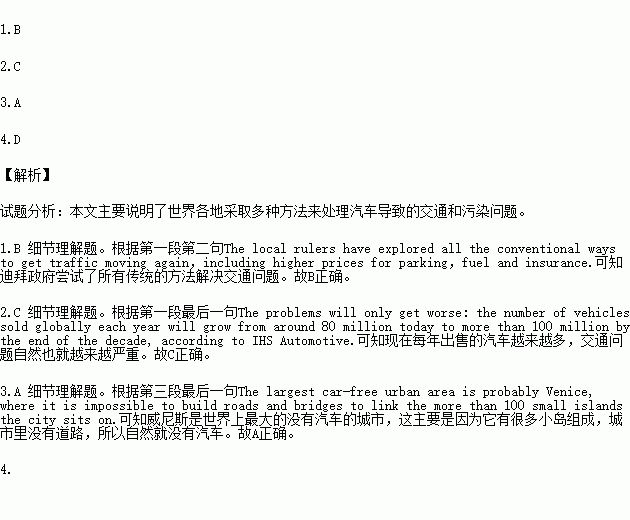题目内容
It does not come as a surprise that Dubai has a growing problem with “tragic”. The local rulers have explored all the conventional ways to get traffic moving again,including higher prices for parking,fuel and insurance. But at a recent conference in Hamburg, Hussain Lootah said that the city may adopt a more strict approach: setting an income level for vehicle ownership.
Mr Lootah’s approach is unlikely to be copied widely, but mayors of other big cities around the world are starting to think about taking severe actions of their own, including complete car bans in inner cities.But the efforts may not be enough to reduce traffic and pollution. The problems will only get worse: the number of vehicles sold globally each year will grow from around 80 million today to more than 100 million by the end of the decade, according to IHS Automotive.
There are already a handful of car-free communities around the world.But these are typically small and often tourist destinations that seek to create a throwback(后退;返祖遗传) in time, such as Sark Island, in the English Channel. The largest car-free urban area is probably Venice, where it is impossible to build roads and bridges to link the more than 100 small islands the city sits on.
Yet pedestrian malls(步行街) and other car-free zones keep popping up in cities around the world. Some cities are considering ways to limit central city access to “green” machines, such as battery-electric vehicles. Hamburg is perhaps the furthest along.
Such extreme plans may fly in a city such as Hamburg. But in many other cities the political resistance even to less far-reaching measures is hard to overcome. Michael Bloomberg, New York’s former mayor, tried twice to introduce a jam charge for much of Manhattan, but his plans were rejected by state lawmakers.
1. From Paragraph 1, we know that ________.
A. Dubai government tries to improve its local incomes
B. Dubai government tries to solve traffic problems
C. Dubai government tries to reduce prices for parking
D. Dubai government tries to offer insurance to locals
2. It is still hard to reduce traffic problems, because ________.
A. Mr Lootah’s approach will be copied widely.
B. mayors take gentle measures toward them.
C. more vehicles will be sold globally each year.
D. complete car bans in inner cities are not made.
3.What causes Venice to be the largest car-free urban area?
A. Its natural geographical characteristics.
B. Its too many tourist destinations.
C. Its reduced number of cars.
D. Its government law on car free.
4.What can we learn from Paragraph 4?
A. People can only walk in central city.
B. All vehicles can be used in central city.
C. Hamburg may not adopt “green” machines.
D. “Green” machines can be accessible in central city.

